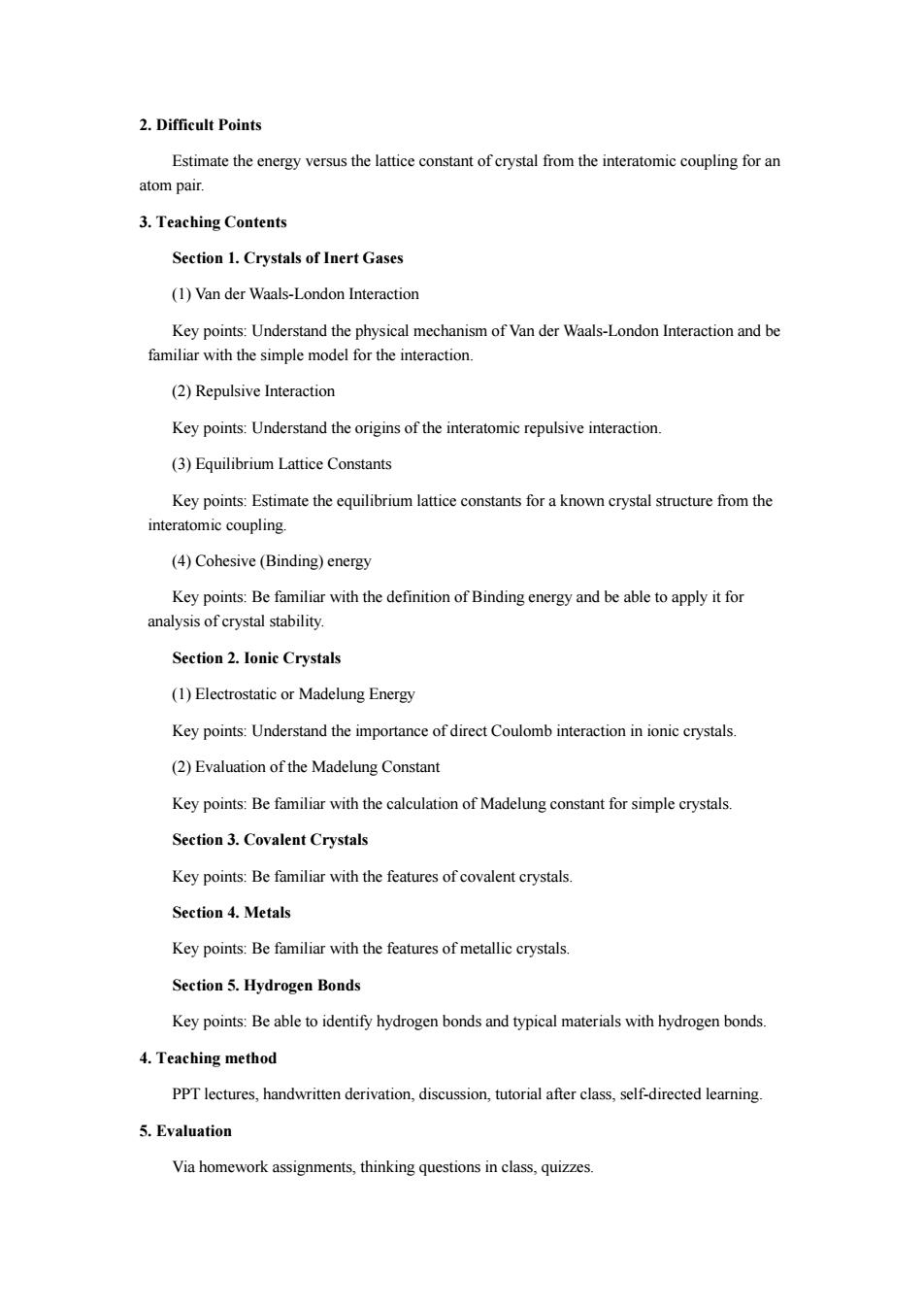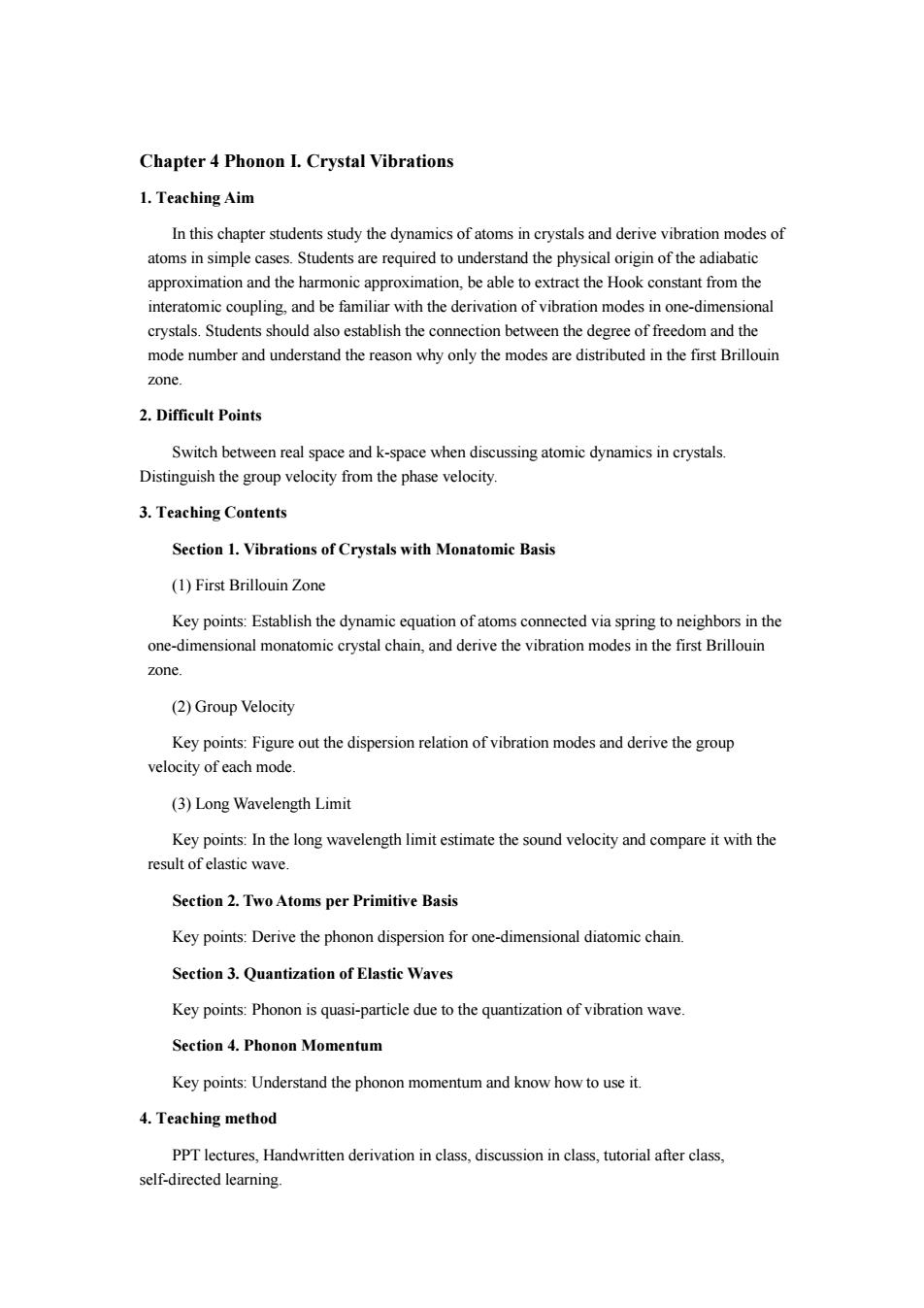
2.Difficult Points Estimate the energy versus the latice constant of crystal from the interatomic coupling for an atom pair. 3.Teaching Contents Section 1.Crystals of Inert Gases (1)Van der Waals-London Interaction Key points:Understand the physical mechanism of Van der Waals-London Interaction and be familiar with the simple model for the interaction. (2)Repulsive Interaction Key points:Understand theoriginsof the interatomic repusive interaction (3)Equilibrium Lattice Constants Key points:Estimate the equilibrium lattice constants for a known crystal structure from the interatomic coupling. (4)Cohesive(Binding)energy Key points:Be familiar with the definition of Binding energy and be able to apply it for analysis of crystal stability. Section 2.Ionic Crystals (1)Electrostatic or Madelung Energy Key points:Understand the importance of direct Coulomb interaction in ionic crystals (2)Evaluation of the Madelung Constant Key points:Be familiar with the calculation of Madelung constant for simple crystals Section 3.Covalent Crystals Key points:Be familiar with the features of covalent crystals. Section 4.Metals Key points:Be familiar with the features of metallic erystals. Section 5.Hydrogen Bonds Key points:Be able to identify hydrogen bonds and typical materials with hydrogen bonds 4.Teaching method PPTlectures,handwritten derivation,discussion,tutorial afer self-directed leaming. 5.Evaluation Via homework assignments,thinking questions in class,quizzes
2. Difficult Points Estimate the energy versus the lattice constant of crystal from the interatomic coupling for an atom pair. 3. Teaching Contents Section 1. Crystals of Inert Gases (1) Van der Waals-London Interaction Key points: Understand the physical mechanism of Van der Waals-London Interaction and be familiar with the simple model for the interaction. (2) Repulsive Interaction Key points: Understand the origins of the interatomic repulsive interaction. (3) Equilibrium Lattice Constants Key points: Estimate the equilibrium lattice constants for a known crystal structure from the interatomic coupling. (4) Cohesive (Binding) energy Key points: Be familiar with the definition of Binding energy and be able to apply it for analysis of crystal stability. Section 2. Ionic Crystals (1) Electrostatic or Madelung Energy Key points: Understand the importance of direct Coulomb interaction in ionic crystals. (2) Evaluation of the Madelung Constant Key points: Be familiar with the calculation of Madelung constant for simple crystals. Section 3. Covalent Crystals Key points: Be familiar with the features of covalent crystals. Section 4. Metals Key points: Be familiar with the features of metallic crystals. Section 5. Hydrogen Bonds Key points: Be able to identify hydrogen bonds and typical materials with hydrogen bonds. 4. Teaching method PPT lectures, handwritten derivation, discussion, tutorial after class, self-directed learning. 5. Evaluation Via homework assignments, thinking questions in class, quizzes

Chapter 4 Phonon I.Crystal Vibrations 1.Teaching Aim In this chapter students study the dynamics of atoms in crystals and derive vibration modes of atoms in simple cases students are required to understand the physical origin of the adiabatic ion,be able toex act the Hook constant from the crystals.Students should also establish the connection between the degree of freedom and the mode number and understand the reason why only the modes are distributed in the first Brillouin zone. 2.Difficult Points Switch between real space and k-space when discussing atomic dynamics in crystals. Distinguish the group velocity from the phase velocity. 3.Teaching Contents Section 1.Vibrations of Crystals with Monatomic Basis (1)First Brillouin Zone Key points:Establish the dynamic equation of atoms connected via spring to neighbors in the one-dimensional monatomic crystal chain,and derive the vibration modes in the first Brillouin zone. (2)Group Velocity Key points:Figure out the dispersion relation of vibration modes and derive the group velocity of each mode. (3)Long Wavelength Limit Key points:In the long wavelength limit estimate the sound velocity and compare it with the result of elastic wave. Section 2.Two Atoms per Primitive Basis Key points:Derive the phonon dispersion for one-dimensional diatomic chain Section 3.Quantization of Elastic Waves Key points:Phonon is quasi-particle due to the quantization of vibration wave. Section 4.Phonon Momentum Key points:Understand the phonon momentum and know how to use it 4.Teaching method PPTlectures,Handwritten derivation in class,discussion in class,tutorial after class
Chapter 4 Phonon I. Crystal Vibrations 1. Teaching Aim In this chapter students study the dynamics of atoms in crystals and derive vibration modes of atoms in simple cases. Students are required to understand the physical origin of the adiabatic approximation and the harmonic approximation, be able to extract the Hook constant from the interatomic coupling, and be familiar with the derivation of vibration modes in one-dimensional crystals. Students should also establish the connection between the degree of freedom and the mode number and understand the reason why only the modes are distributed in the first Brillouin zone. 2. Difficult Points Switch between real space and k-space when discussing atomic dynamics in crystals. Distinguish the group velocity from the phase velocity. 3. Teaching Contents Section 1. Vibrations of Crystals with Monatomic Basis (1) First Brillouin Zone Key points: Establish the dynamic equation of atoms connected via spring to neighbors in the one-dimensional monatomic crystal chain, and derive the vibration modes in the first Brillouin zone. (2) Group Velocity Key points: Figure out the dispersion relation of vibration modes and derive the group velocity of each mode. (3) Long Wavelength Limit Key points: In the long wavelength limit estimate the sound velocity and compare it with the result of elastic wave. Section 2. Two Atoms per Primitive Basis Key points: Derive the phonon dispersion for one-dimensional diatomic chain. Section 3. Quantization of Elastic Waves Key points: Phonon is quasi-particle due to the quantization of vibration wave. Section 4. Phonon Momentum Key points: Understand the phonon momentum and know how to use it. 4. Teaching method PPT lectures, Handwritten derivation in class, discussion in class, tutorial after class, self-directed learning